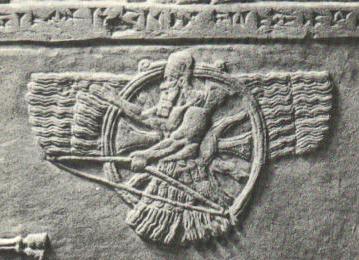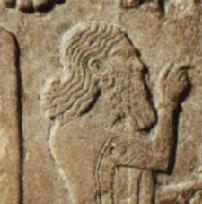Middle Assyrian Period (1392-1180)
 |
| Ashur, the Assyrian national god |
The laws of the Middle Kingdom were very misogynistic. Women of nobility were required to wear veils at all times, could not go out in public alone, and they had no voice or rights. Husbands could beat, maim or kill their wives with little or no threat of punishment. It is during this period that the national god Ashur becomes predominantly a war god and the king his high priest. This period is sometimes called Middle Assyrian Empire.
Eriba-Adad I (1392-1363)-Son of Ashur-Bel-Nisheshu. In alliance with the Hittites, he gained independence from Mitanni.
Ashur-Ubbalit I (1363-1328)-Son of Eriba-Adad. He was able to divide Mitanni between himself and the small state of Alshe (upper Tigris area). He took the title of "Great King" and "King of the Universe" and called himself "Brother of the Pharaoh". In 1333 the king of Babylon, who was Ashur-Ubbalit's grandson, was assassinated. In retaliation he invaded, intervened in the short civil war, overthrew Nazibugash and helped Kurigalzu II gain the throne.
Enlil-Nirari (1328-1318)-Son of Ashur-Ubbalit. He was attacked by Kurigalzu of Babylon, most probably as a consequence of the assassination of Karahardash and the ensuing civil war. They eventually made peace.
Arik-Dan-Ili (1318-1308)-Son of Enlil-Nirari. He campaigned in the Zagros against the barbarians.
Adad-Nirari I (1308-1275)-Brother of Arik-Dan-Ili. He conquered, at least temporarily, as far as Karkemish and also warred with Babylon.
Shalmaneser I (Shulanu-Asharedu) (1275-1245)-Son of Adad-Nirari. His actual name was Shulanu-Asharedu. He fought wars of conquest in the name of the god Ashur, which continued into the reign of his successor. He subdued the north (Armenia) and the Zagros and then conquered the remnants of the Mitanni Empire. His reign was continually plagued by incursions from the Kassites of Babylon.
Tukulti-Ninurta I (1245-1208)-Son of Shalmaneser. He waged very brutal warfare, including the deportation  of conquered peoples in order to destroy their national consciousness. For a time he held parts of Syria, including Mari, and in 1225 he captured Babylon and its King. He installed puppet governors who were only able to rule for eight years. He built a new capital, Kar-Tukulti- Ninurta. Eventually his son and the nobles revolted. He was besieged in his palace and killed when it was set on fire.
of conquered peoples in order to destroy their national consciousness. For a time he held parts of Syria, including Mari, and in 1225 he captured Babylon and its King. He installed puppet governors who were only able to rule for eight years. He built a new capital, Kar-Tukulti- Ninurta. Eventually his son and the nobles revolted. He was besieged in his palace and killed when it was set on fire.
Assyrian power declined because of incursion by Arameans and the fall of the Hittites, which disrupted trade routes. Troubled by the Sea Peoples?
Ashur-Nadin-Apli (1207-1203)-Son of Tukulti-Ninurta I. He revolted against his father and killed him. He in turn was possibly overthrown by Ashur-Nirari.
Ashur-Nirari III (1203-1197)-He probably was an usurper who seized power in a coup. He in turn was overthrown himself.
Enlil-Kudurri-Usur (1197-1192)-Son of Tukulti-Ninurta I. He seized the throne from the usurper, but was in turn overthrown by Ninurta-Apal-Ekur.
Ninurta-Apal-Ekur (1192-1180)-He was a son of Ili-Ihadda, a descendent of Eriba-Adad I. He seized the thrown in a coup and founded a dynasty that lasted until nearly the end of the Empire.


 of conquered peoples in order to destroy their national consciousness. For a time he held parts of Syria, including Mari, and in 1225 he captured Babylon and its King. He installed puppet governors who were only able to rule for eight years. He built a new capital, Kar-Tukulti- Ninurta. Eventually his son and the nobles revolted. He was besieged in his palace and killed when it was set on fire.
of conquered peoples in order to destroy their national consciousness. For a time he held parts of Syria, including Mari, and in 1225 he captured Babylon and its King. He installed puppet governors who were only able to rule for eight years. He built a new capital, Kar-Tukulti- Ninurta. Eventually his son and the nobles revolted. He was besieged in his palace and killed when it was set on fire.